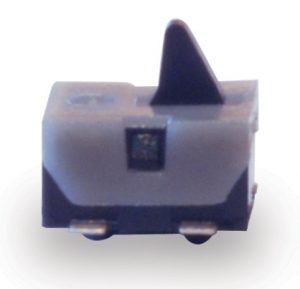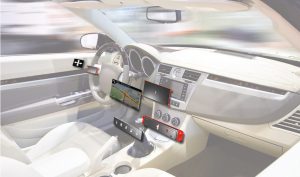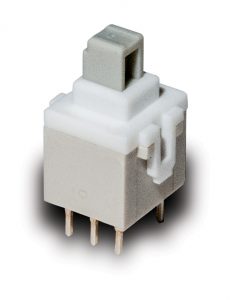
Optimizing and customizing electromechanical components for automotive applications
By Eric Grange, industry marketing manager – automotive, C&K
Automation / Robotics Circuit Protection Engineering Supply Chain custom electromechanical electromechanical componentsUser interface is an extremely important aspect of any vehicle ‘experience.’ Obviously, electromechanical components, including switches, in automotive applications must provide high reliability and long operating life but their utility can’t end there. Switches must also add to the look (design), a feel (feedback) and architecture (electrical ratings and arrangement, fit to function) of a vehicle’s keyfob, center console, steering wheel or any other in-cabin interfaces.
Known in the industry as ‘haptics,’ the touch, feel and sound of a switch’s actuation greatly contribute to a user’s experience of a vehicle. Influenced also by perceived quality from consumer electronics, automotive design engineers want user interfaces to respond and provide feedback in specific ways that are unique to the automobile. Haptic features are often customized for specific vehicles and manufacturers, and are often accomplished through advanced switch configurations. These advanced switch configurations must combine ruggedness with design flexibility to meet automotive requirements.
Sealing
A commonality of every harsh environment application is the need for ruggedized components that can withstand brutal environments, especially outside the vehicle or under the bonnet. Switches sealed to IP40, IP65, IP67 and IP68 specifications that are resistant to contamination by, dust, dirt, salt and water are necessary in most automotive applications. Combating environmental elements is often accomplished with switch designs featuring an internal seal to protect the switching mechanism, as well as an external panel seal to keep liquids from entering the panel or enclosure. Silicon rubber caps are also employed to prevent the ingress of fluids that could adversely affect the function of standard switches.
Rugged switch designs for automotive vehicles also need to be resistant to extreme temperatures, vibration and shock. Depending on the specific, advanced snap-acting, tactile, push button and toggle switches are available with IP67/IP68 ratings that provide high levels of reliability and predictability. Reliability and predictable behavior is directly linked to the compatibility of the switch based on the mechanical environment of the unit and the final OEM specification. Such specifications are becoming more important for OEMs as they have to manage strategies for safe mechatronics systems, led by ISO 26262 standards. Switch manufacturers must simulate the potential environmental conditions a switch will encounter over its operating life to ensure their design achieves the specified robustness.
Haptics
As the gateway to a user interface, a switch solution must have a desirable appearance, feel and sound. Switch manufacturers must work closely with automotive makers to optimize aesthetics, ergonomics and performance.
Typical switching functions in automotive applications, such as front-panels and dashboards, require robust push button switches. Sealed up to IP68-ratings, push button switches can be designed to provide excellent tactile feedback with specific travel and actuation forces. Push button switches also provide an operating life of more than one million cycles which makes them well-suited for use in automotive vehicles and increase the reliability confidence factor.
Ultra-miniature tactile switches are ideal for keyfobs, as they combine a high-operating life with long-term reliability and low current compatibility, while a snap-switch would most likely be used in a vehicle’s FOB reader. Both switches can be customized to provide precise feedback.
The audible response of a switch is another important way for vehicle manufacturers to differentiate their vehicles. This feature can be customized to deliver a specified sound or click when actuated. Automotive OEMs are focusing more on these sound responses and consider the acoustic response as part of their branding. The audible response is highly dependent on the switch design, and vehicle manufacturers need to get the same sound response for all units, regardless of the advanced switch configuration.
In order to provide solutions that deliver repeatable audible responses, switch manufacturers have developed established platforms that allow designs to carry over to different applications. This unique offer provides high-reliability and consistent haptics by an “automotive proven” series, while also achieving drastically reduced development cost and time.
Implementing New Technologies
Consumers now expect touch screens in their smart phones, vehicle entertainment systems, GPS systems and computer monitors. Touch sensing controls, including tactile screens, can now be implemented into almost any electronic device, including center console interfaces. This “Clicker” function can be enabled with any touch-sensitive surface and provides uniform haptics over any surface. The simple mechanical system integrates low-profile tactile switches with the actuating superstructure to provide a clickable touch-sensing system. Based on a structure with supporting points, the actuator collects and transmits the force from the touching surface to the switch with minimal distortion or power consumption. The technology is more efficient than “hinged” solutions and provides a smooth and uniform click. Multiple configurations, structures and profiles can be developed depending on the application and room available for integration, from 2.5mm to 10mm.
In addition, the Clicker technology can combine with multiple key areas based on the same actuating surface. Each area of a key or button can be used for a pre-selected function. Selecting the function is managed through actuation on the whole surface. The main benefit is that instead of managing separated keys/buttons, the unit can be managed by a single flush surface with haptics, reducing integration issues and simplifying some features like key alignment, backlighting and tactile difference between keys.
Assembly
Electromechanical components for automotive applications often feature quick connections that support modular installation so that they can be plugged into the panel and locked firmly into place, simplifying both assembly and maintenance. This also lets users store individual switch elements separately and configure them during final assembly to meet application-specific needs, while saving storage space and costs.
Constant work on haptics leads to a reduction of key travel and reaching homogeneity among all controls. The consequence is a challenging tolerance reduction along all the mechanical characteristics, especially switch travel. Constant work on high precision stamping, overmodling and assembly leads to offer such improvement.
Manufacturers have also developed push button switches that offer panel-mounting options to simplify assembly. Rear panel-mounting switches are ideal for applications where multiple switches are going to be mounted to a PCB. Customers can mount them to the PCB first, then the entire assembly can be installed into the armrest or panel. This allows for a much easier installation compared to traditional front mounted switches that require the mounting hardware to be tightened from behind the panel, which is sometimes hard to get to; as well as having to run all the leads to the mating connectors on the PCB. Rear mounted switches allow customers to install the hardware from the top and still achieve the same look while simplifying the installation process.
Custom Electromechanical Solutions
OEMs are approaching electromechanical component manufacturers for more than just the switch. By utilizing a switch manufacturer for designs beyond the switch itself, increased flexibility in design can be realized. Switch dimensions are becoming more critical, making it imperative to work closely with customers to discern all details. Today, it is less about the switch being mounted to a PC board or adding wire leads or a connector to the switch, and more about defining the issues that need to be solved, and having a system approach. Because switch manufacturers are now dealing with the entire module, they are spending an increasing amount of time with customers to determine how the module is being impacted in the application to assess potential challenges that were not previously considered.
By working closely with customers in all phases of the design process, switch manufacturers can identify materials that interface with the operator, and those in the actual contact mechanism can be re-evaluated and altered to conform to performance, reliability, lifespan and robustness standards. For example, some manufacturers are now offering switch packages with multi-switching capability and high over-travel performance, with various core-switching technologies such as opposing tactile switches or a dome array on a PC board. Such packages often include additional PC board-mounted integrated electronics, custom circuitry, and industry standard connectors for the complete solution.
Still other solutions optimized for automobiles, such as interior headliners, feature not only customized switches with insert molded housing and custom circuitry and termination, but also paint and laser etched switch button graphics and decoration capabilities, as well as backlighting for nighttime use. Today, switch manufacturers are doing even these customized graphics and decorations in-house.
Although the electromechanical components are some of the last devices designed or specified into a center console, dashboard or steering wheel, switches are one of the most important components within a system. Each automotive manufacturer has different performance requirements, external presentations, internal spacing and footprint restrictions. As such, each vehicle requires different packaging and orientation for switches to achieve functional and performance objectives. Customized haptic options (actuation travel, force and audible sound), ergonomic options (illumination, decoration, appearance), sealing options, circuitry configurations, housing styles, mounting styles (including threaded or snap-in mounting) and termination options are integral to meeting these application requirements.
Combining innovative electromechanical designs with complete switch assemblies often affords customers greater flexibility and customization options that reduce assembly and manufacturing costs while improving performance and reliability. Working closely with the switch manufacturer to solve design problems and implement customized performance requirements can yield faster time-to-market by streamlining the prototyping and production ramp-up stages, thereby bringing the finished product to market more quickly.




